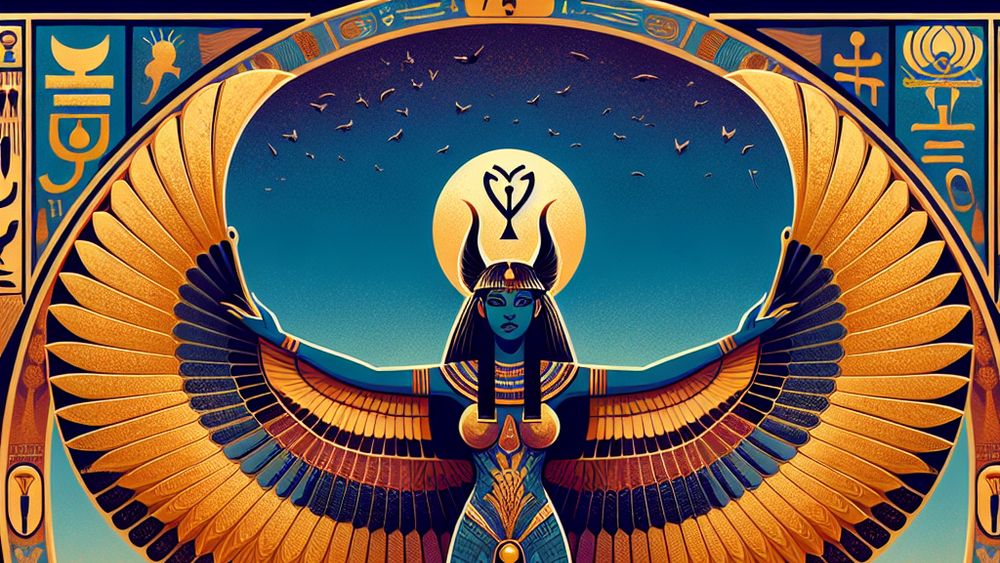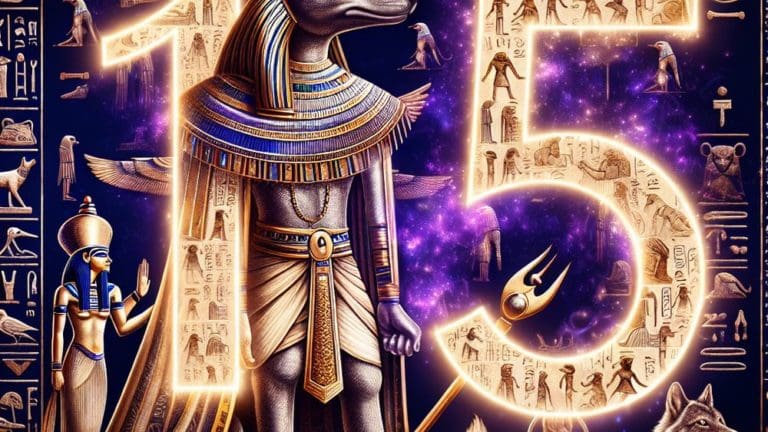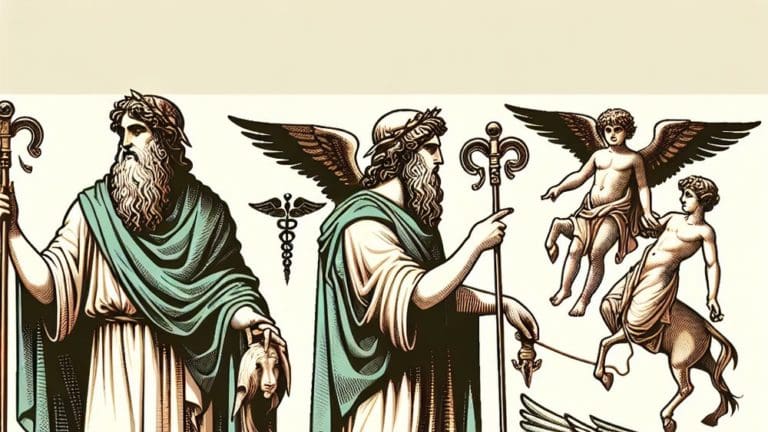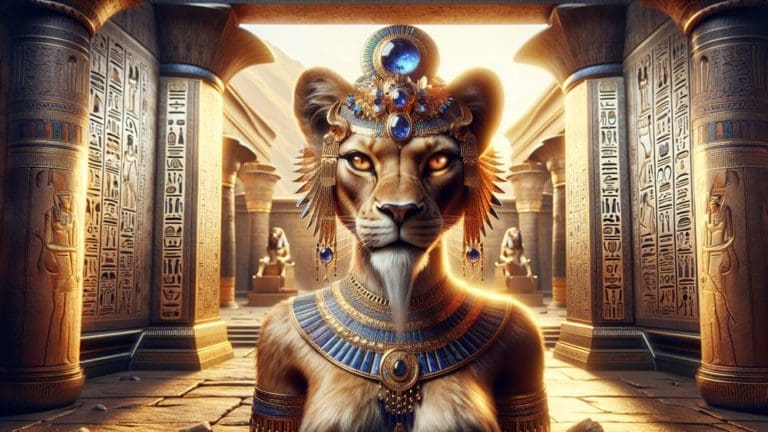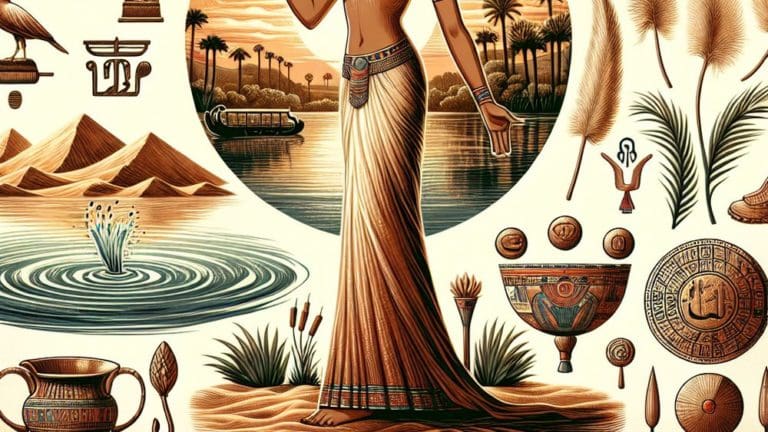Egyptian God Bat: Ancient Deity Of Fertility And Sky
Egyptian God Bat: Ancient Deity Of Fertility And Sky
Have you ever wondered about the lesser-known deities of ancient Egypt, those shrouded in mystery even in the brightness of today’s scholarly lights? The Egyptian god Bat is one such enigmatic figure, a deity whose wings stretch wide into the realms of fertility and the sky, yet remains somewhat in the shadows, teasing the curiosity of historians and mythologists alike.
Key Points:
- Egyptian god Bat is an ancient deity associated with fertility and the sky.
- Bat was venerated during the Predynastic period in Egypt around 3200 BCE.
- Bat was primarily worshipped in Upper Egypt, with a significant center in Hu near Thebes.
- Symbols associated with Bat include cow horns with stars, a human face with cow ears, and the sistrum.
- Over time, Bat’s identity merged with that of Hathor, another cow goddess of fertility and love.
- Bat’s worship declined after the New Kingdom but remained in localized practices and cult centers.
- Bat’s influence persisted in later Egyptian religion through her symbols and attributes.
She beckons us to dive into her story, to unearth the secrets that lie buried beneath centuries of sand and silence. What esoteric knowledge might we discover about ancient Egyptian beliefs and practices through the lens of Bat’s worship? This journey is not just an exploration of the past; it is an invitation to connect with the mysteries of a world that was, foretelling the echoes of what still can be found today.
The Historical Significance of Bat in Ancient Egypt
The significance of Bat in ancient Egyptian culture can hardly be overstated. As one of the oldest deities, her imagery and concepts are woven into the very fabric of Egyptian mythology, offering insights into the evolution of religious worship in the region.
Origins and Early Worship of Bat
Tracing back to the Predynastic period, Bat was venerated as one of the earliest deities in Egypt, embodying the essence of fertility and the inherent power of womanhood. She was primarily worshipped in Upper Egypt, her presence prominent in the life and rituals of early Egyptian societies.

- The worship of Bat dates back to circa 3200 BCE.
- Her primary center of worship was in the region known as Hu, near what later would become the city of Thebes.
- Symbols associated with Bat included the sistrum, a musical instrument, and cow horns, with which she was often depicted.
Bat, an ancient Egyptian deity, symbolized fertility and womanhood, worshipped in Upper Egypt with her primary center of worship in the region near Thebes.
Bat’s Role in Fertility and the Sky
As a deity of fertility, Bat was believed to bestow bountiful harvests and ensure the prosperity of crops and people alike. Her connection to the sky, manifesting through her cowish face with stars for eyes, symbolized an overarching protective gaze over the land.
- Bat was invoked for protection during childbirth and to foster maternal well-being.
- Her association with the stars and the mansion of the sky underlines the ancient Egyptians’ understanding of the cosmos’s influence on agriculture and fertility.
Depictions and Symbols of Bat in Ancient Art
The visual representation of Bat in ancient Egyptian art is both distinct and telling, offering fascinating insights into how the Egyptians conceived her role and significance.
| Symbol | Significance |
|---|---|
| Cow horns with stars within them | Represents her connection to the fertility of the land and her dominion over the night sky. |
| Human face with cow ears | Symbolizes her nurturing nature and her ties to both human and divine realms. |
| Sistrum | An instrument often associated with Bat, underscoring her role in music and ritual celebrations. |
Bat in ancient Egyptian art symbolizes fertility, nurturing nature, and music, showcasing her multifaceted role and significance in the culture.
The Transformation of Bat’s Worship Over Time
The reverence for Bat underwent significant changes as the political and cultural landscapes of Egypt evolved. Initially, a major deity in Upper Egypt, her attributes and iconography gradually merged with those of other gods and goddesses, most notably Hathor.
- By the Middle Kingdom, Bat’s distinct identity began to be absorbed into that of Hathor, another cow goddess of fertility and love.
- The Narmer Palette, dating back to the unification of Upper and Lower Egypt, features Bat prominently, indicating her importance in early dynastic Egypt.
- Throughout the New Kingdom and beyond, Bat’s presence in Egyptian religious life diminished, though she remained a figure in the pantheon, revered in more localized practices and cult centers.
The Connection Between Bat and Other Egyptian Deities
The enigmatic deity Bat, a primordial goddess of fertility and the sky, shares a unique connection with the pantheon of ancient Egyptian gods and goddesses. Her role and attributes intertwine with those of other significant deities, hinting at the rich tapestry of beliefs that defined the spiritual landscape of ancient Egypt.
Bat and Hathor: A Merging of Identities
Over time, Bat’s identity began to overlap with that of Hathor, the renowned cow goddess, leading to a fascinating blend of attributes and worship practices. This amalgamation of identities is particularly intriguing, as both deities represent life, fertility, and the bounty of nature. This fusion is evidenced by:
- The depiction of both goddesses with cow ears or a human face with cow horns, symbolizing fertility and motherhood.
- The use of the sistrum, an instrument associated with Hathor, in the worship of Bat, highlighting the merger in their cult practices.
- The Narmer Palette and other artifacts from Upper Egypt, showing Bat with features later attributed to Hathor, suggesting a gradual merging over time.
- Shared centers of worship, where both goddesses were venerated, further illustrating the close association between Bat and Hathor.
The merging of Bat and Hathor’s identities illustrates the fluid nature of Egyptian religion, where deities could combine aspects over time, enriching the spiritual and mythological landscape.
The merging of Bat and Hathor’s identities showcases the fluid nature of Egyptian religion and the enriching blend of attributes over time.
Comparative Analysis with Other Fertility and Sky Gods
Bat held a unique position among the ancient Egyptian deities, blending the aspects of the sky and fertility in ways distinct from her counterparts. When compared to other fertility and sky gods, Bat’s attributes reveal her as a goddess of both the heavens and the earth. This comparison highlights:
- Nut, the sky goddess, who encompassed the stars and the cosmos, whereas Bat’s celestial aspect focused more on the milky way, likened to a pool of cow’s milk.
- Osiris, god of the afterlife and fertility, whose connection to the earth’s bounty and resurrection had parallels with Bat’s life-giving qualities, though she predominantly symbolized fertility in a maternal sense.
- Isis, another fertility goddess, shared commonalities with Bat in her role as a protector and mother figure, but without the specific sky element present in Bat’s worship.
This analysis underlines Bat’s unique blend of powers, connecting the sky’s vastness with the earth’s fertility, making her an intriguing figure among the Egyptian pantheon.
The Influence of Bat on Later Egyptian Religion
The influence of the goddess Bat on later Egyptian religion showcases the enduring legacy of her worship. Despite the prominence of other deities in the evolving religious landscape, Bat’s characteristics and symbols persisted, weaving into the fabric of Egyptian spirituality. This influence is visible in:
- The continued integration of Bat’s attributes in other deities, such as Hathor and Isis, demonstrating the lasting impact of her fertility and maternal aspects.
- The presence of Bat’s symbolism, like the sistrum and cow horns, in ceremonies and art, reinforcing her significance even as direct worship waned.
- Texts and inscriptions from Middle Kingdom and later periods reference Bat’s traits, indicating an ongoing reverence for her aspects of protection and fertility.
Despite the transformation of her worship, Bat’s essence – a blend of sky’s expanse and earth’s fertility – remained a potent symbol throughout Egyptian history, exemplifying the complexity and depth of ancient Egyptian religious beliefs.

Bat’s influence on Egyptian religion remained strong over time, with her symbols and attributes persisting in the worship of other deities and in various aspects of Egyptian spirituality.
FAQs
1. How was Bat worshipped in ancient Egypt?
In ancient Egypt, Bat was worshipped predominantly in the region of Upper Egypt, emphasizing her significance as a cow goddess associated with fertility and the cosmos. Rituals and offerings to Bat often mirrored those given to other deities, showcasing her importance in the ancient Egyptian pantheon.
2. What symbols are associated with Bat?
Symbols associated with Bat include the sistrum, a musical instrument that was closely linked to her. Additionally, depictions often feature her with cow ears or as a woman with bovine features, highlighting her connection to fertility and motherhood within the ancient Egyptian culture.
3. How did Bat’s role in Egyptian mythology evolve?
Bat’s role in Egyptian mythology evolved significantly over time, from an independent deity to one closely associated with Hathor, another important goddess of love, beauty, and music. This transition reflects the fluid nature of ancient Egyptian religion, where gods and goddesses often merged identities or attributes.
4. What is the relationship between Bat and Hathor?
The relationship between Bat and Hathor illustrates a common occurrence in ancient Egyptian religion where deities merged over time. Bat, initially worshipped as a cow goddess of fertility, gradually became closely identified with Hathor, leading to a blending of their worship and iconography.
Conclusion
Exploring the mysteries of the Egyptian god Bat offers us a fascinating glimpse into how ancient Egyptians viewed the world around them, merging nature, cosmos, and spirituality into a rich tapestry of belief. Bat’s evolution from a local goddess to a figure integrated within the broader pantheon of Egyptian gods and goddesses also mirrors the dynamic and intertwined nature of ancient Egyptian religion itself. As we delve deeper into the stories and symbols that survived through millennia, the figure of Bat invites us to reflect on the changing faces of worship and the enduring power of the divine feminine. Thank you for joining me on this intriguing journey into the past, where each discovery sheds light on the complexity and beauty of ancient beliefs. Until next time, keep exploring the mysteries that history has to offer. Warm regards, Cedric.

